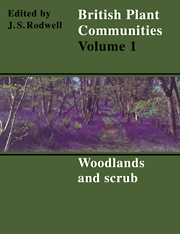Book contents
- Frontmatter
- Contents
- List of Figures
- Foreword
- Preface and Acknowledgements
- Preamble
- General Introduction
- Woodlands and Scrub
- Introduction to Woodlands and Scrub
- Key To Woodlands and Scrub
- Community Descriptions
- W1 Salix Cinerea-Galium Palustre woodland
- W2 Salix Cinerea-Betula Pubescens-Phragmites Australis Woodland
- W3 Salix Pentandra-Carex Rostrata Woodland
- W4 Betula Pubescens-Molinia Caerulea Woodland
- W5 Alnus Glutinosa-Carex Paniculata Woodland
- W6 Alnus Glutinosa-Urtica Jzozca Woodland
- W7 Ainus Glutinosa-Fraxinus Excelsior-Lysimachia Nemorum Woodland
- W8 Fraxinus Excelsior-Acer Campestre-Mercurialis Perennis Woodland
- W9 Fraxinus Excelsior-Sorbus Aucuparia-Mercurialis Perennis Woodland
- W10 Quereus Robur-Pteridium Aquilinum-Rubus Fruticosus Woodland
- W11 Quereus Petraea-Betula Pubescens-Oxalis Acetosella Woodland
- W12 Fagus Sylvatica-Mercurialis Perennis Woodland
- W13 Taxus Baccata Woodland
- W14 Fagus Sylvatica-Rubus Fruticosus Woodland
- W15 Fagus Sylvatica-Deschampsia Flexuosa Woodland
- W16 Quereus spp.-Betula spp.-Deschampsia Flexuosa Woodland
- W17 Quereus Petraea-Betula Pubescens-Dicranum Majus Woodland
- W18 Pinus Sylvestris-Hylocomium Splendens Woodland
- W19 Juniperus Communis Ssp. Communis-Oxalis Acetosella Woodland
- W20 Salix Lapponum-Luzula Sylvatica Scrub
- W21 Crataegus monogyna-Hedera helix scrub
- W22 Prunus Spinosa-Rubus Fruticosus Scrub
- W23 Ulex Europaeus-Rubus Fruticosus Scrub
- W24 Rubus Fruticosus-Holcus Lanatus Underscrub
- W25 Pteridium Aquilinum-Rubus Fruticosus Underscrub
- Index of Synonyms to Woodlands and Scrub
- Index of Species in Woodlands and Scrub
- Bibliography
W4 - Betula Pubescens-Molinia Caerulea Woodland
Published online by Cambridge University Press: 04 July 2020
- Frontmatter
- Contents
- List of Figures
- Foreword
- Preface and Acknowledgements
- Preamble
- General Introduction
- Woodlands and Scrub
- Introduction to Woodlands and Scrub
- Key To Woodlands and Scrub
- Community Descriptions
- W1 Salix Cinerea-Galium Palustre woodland
- W2 Salix Cinerea-Betula Pubescens-Phragmites Australis Woodland
- W3 Salix Pentandra-Carex Rostrata Woodland
- W4 Betula Pubescens-Molinia Caerulea Woodland
- W5 Alnus Glutinosa-Carex Paniculata Woodland
- W6 Alnus Glutinosa-Urtica Jzozca Woodland
- W7 Ainus Glutinosa-Fraxinus Excelsior-Lysimachia Nemorum Woodland
- W8 Fraxinus Excelsior-Acer Campestre-Mercurialis Perennis Woodland
- W9 Fraxinus Excelsior-Sorbus Aucuparia-Mercurialis Perennis Woodland
- W10 Quereus Robur-Pteridium Aquilinum-Rubus Fruticosus Woodland
- W11 Quereus Petraea-Betula Pubescens-Oxalis Acetosella Woodland
- W12 Fagus Sylvatica-Mercurialis Perennis Woodland
- W13 Taxus Baccata Woodland
- W14 Fagus Sylvatica-Rubus Fruticosus Woodland
- W15 Fagus Sylvatica-Deschampsia Flexuosa Woodland
- W16 Quereus spp.-Betula spp.-Deschampsia Flexuosa Woodland
- W17 Quereus Petraea-Betula Pubescens-Dicranum Majus Woodland
- W18 Pinus Sylvestris-Hylocomium Splendens Woodland
- W19 Juniperus Communis Ssp. Communis-Oxalis Acetosella Woodland
- W20 Salix Lapponum-Luzula Sylvatica Scrub
- W21 Crataegus monogyna-Hedera helix scrub
- W22 Prunus Spinosa-Rubus Fruticosus Scrub
- W23 Ulex Europaeus-Rubus Fruticosus Scrub
- W24 Rubus Fruticosus-Holcus Lanatus Underscrub
- W25 Pteridium Aquilinum-Rubus Fruticosus Underscrub
- Index of Synonyms to Woodlands and Scrub
- Index of Species in Woodlands and Scrub
- Bibliography
Summary
Synonymy
Betuletum pubescentis (Hueck 1929) R.Tx. 1955 p.p.; Alder woodland types 2a & 3a McVean 19566; Woodwalton Molinia sere Poore 19566 p.p.', Woodwalton Birch wood Poore 19566; Waveney/Ouse fens Community R Bellamy & Rose 1961; Clarepool Moss woodland Sinker 1962; Malham Tarn Birch woods Proctor 1974, Adam et al. 1975; Woodland Molinia nodum Daniels 1978; Betula-Sphagnum flexuosum nodum Daniels 1978; Betulo-Myricetum molinietosum Wheeler 1980c; Osmundo-Alnetum sphagnetosum Wheeler 1980c; Betula pubescens woodland Meres Report 1980; Sphagnum palustre-Betula pubescens Community Birse 1982; Sphagno-Salicetum atrocinereae Birse 1984 p.p.
Constant species
Betula pubescens, Molinia caerulea, Sphagnum recurvum/palustre.
Rare species
Dryopteris cristata.
Physiognomy
The general floristic and physiognomic features of the Betula pubescens-Molinia caerulea woodland are very simple. Betula pubescens is the only constant woody species and it is almost invariably the dominant, though the canopy it forms is often rather open, with wellspaced individuals. Quite commonly, the trees have a moribund look: infestation with Piptoporus betulinus is frequent and its large fruiting bodies can often be seen on birches that have fallen over or are obviously dying upright. B. pendula is typically very scarce though it is sometimes to be found in local abundance invading drier stands (as at Woodwalton: Poore 19566). Indeed, no other tree is even occasional throughout: Alnusglutinosa comes a poor second to B. pubescens (though it is a little more common in the Juncus sub-community and locally dominant there) and oaks are typically infrequent. In marked contrast to woodlands on more base-rich soils, Fraxinus excelsior is extremely uncommon here.
Smaller woody species are also few in number and the understorey is characteristically sparse. Salix cinerea is the most frequent shrub and sometimes it grows sufficiently tall to break the birch canopy making stratification indistinct. S. caprea, S. pentandra and S. aurita are also sometimes found and very occasionally Corylus avellana, Crataegus monogyna and Ilex aquifolium occur. B. pubescens saplings are quite common though they rarely form the dense thickets so typical of much birch invasion. Young Alnus and oaks occur infrequently.
The most distinctive feature of the field layer here is the consistent presence and often great abundance of Molinia caerulea, which often seems to form an even grassy sward but which, on close inspection, is found in its characteristic tussocky form with systems of litterlined runnels in which the vascular associates and bryophytes are disposed in mosaics.
- Type
- Chapter
- Information
- British Plant Communities , pp. 72 - 79Publisher: Cambridge University PressPrint publication year: 1991

